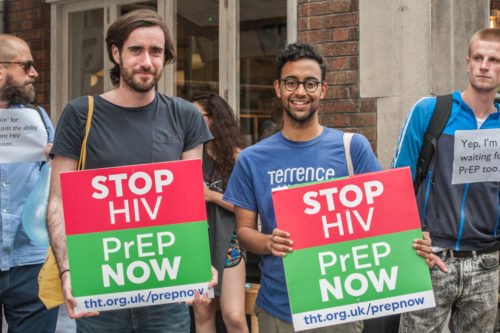 PrEP (pre-exposure prophylaxis) should be offered as a matter of urgency to gay men with a recent STI or multiple condomless partners, found an analysis of men who acquired HIV in the deferred arm of the PROUD study.
PrEP (pre-exposure prophylaxis) should be offered as a matter of urgency to gay men with a recent STI or multiple condomless partners, found an analysis of men who acquired HIV in the deferred arm of the PROUD study.Analysis of men who acquired HIV in the deferred arm of the PROUD study highlights two risk factors that are far more important than any others. “A recent history of syphilis or rectal chlamydia/gonorrhoea, or multiple ncRAI (receptive anal intercourse without a condom) partners indicates a high imminent risk of HIV infection,” Ellen White of University College London and colleagues at the National Institute for Health and Care Excellence – Manchester, London School of Hygiene and Tropical Medicine, Public Health England, Chelsea and Westminster Hospital NHS Foundation Trust, Royal Sussex County Hospital, Brighton and Sussex University Hospitals NHS Trust, Brighton and Sussex Medical School, University of Sussex write. “MSM (men who have sex with men) with any of these characteristics should be offered PrEP (pre-exposure prophylaxis) as a matter of urgency.”
The analysis is based on the 268 participants who took part in PROUD, the study of PrEP in England, and were randomly allocated to the deferred arm (those who did not initially receive PrEP).
Participants’ median age was 35; 40% were born outside the UK and 70% were recruited at a London clinic. In the previous year, 40% had been diagnosed with rectal chlamydia, rectal gonorrhoea or syphilis. There was a wide range of numbers of sexual partners between participants, with half having more than ten partners in the previous three months. This was a cohort at unusually high risk of HIV, who are not representative of the wider population of gay men in England, but do reflect a group who were motivated to take PrEP.
Among those in the deferred arm, 21 individuals acquired HIV during 239 person-years of follow-up. This equates to a very high HIV incidence of 8.8%, but incidence varied according to the risk factors reported on entry to the study.
Incidence was 17.2% in individuals who had been diagnosed with rectal chlamydia, rectal gonorrhoea or syphilis in the previous year.
Incidence was 13.6% in individuals who reported having receptive anal sex, without a condom, with at least two partners in the previous three months.
Incidence was 1.1% in individuals with neither of these two risk factors.
Other ways of counting partner numbers (numbers of anal sex partners and numbers of receptive anal sex partners) were also associated with HIV infections, but the strongest predictor was the one mentioned above. On the other hand, there were no HIV infections in those men who reported that the only condomless sex they had was as the insertive partner (top).
There were more HIV infections in men who reported chemsex, had taken more HIV tests in the past year, had taken post-exposure prophylaxis (PEP) in the past year, and who were in full-time employment, but these did not equate to statistically significant increases in incidence.
“The results should inform eligibility criteria for MSM in the UK and similar populations elsewhere in Europe,” the authors say. All international guidelines include anal intercourse without a condom as a criterion, but generally without specifying the number of partners. Other criteria in guidelines include a recent diagnosis with a bacterial sexually transmitted infection (STI), the use of PEP and sexualised drug use.
In this study, STIs in the throat or penis were not associated with an increased HIV risk, suggesting that PrEP eligibility criteria should focus on rectal STIs and syphilis.
Abstract
Objectives: Pre-exposure prophylaxis (PrEP) is a highly effective method of HIV prevention for men who have sex with men (MSM). However, uncertainty remains around the optimal eligibility criteria for PrEP, specifically whether there are subgroups at low risk of HIV for whom PrEP might not be warranted.
Methods: PROUD was an open-label waitlist trial design that randomised MSM attending participating sexual health centres in England to receive PrEP immediately (IMM) or after a deferral period of 1 year (DEF). This analysis is based on participants who were randomised to the deferred arm, when they did not have access to PrEP. HIV incidence was compared between subgroups defined by baseline characteristics.
Results: Overall, 21 participants acquired HIV infection over 239.3 person-years (PY) follow-up, yielding an incidence rate of 8.8/100 PY (95% CI 5.4 to 13.4). Two highly significant predictors for HIV acquisition were identified. Men with a self-reported diagnosis of syphilis, rectal chlamydia (CT) or rectal gonorrhoea (GC) in the previous 12 months had an incidence of 17.2/100 PY (95% CI 9.7 to 28.5); those reporting receptive anal intercourse without a condom (ncRAI) with two or more partners in the previous 3 months had an incidence of 13.6/100 PY (95% CI 7.9 to 21.7). The incidence rate among participants lacking both of these risk factors was 1.1/100 PY (1/87.6, 95% CI 0.03 to 6.4).
Conclusions: The high HIV incidence in PROUD suggests that most participants appropriately judged their need for PrEP. Eligibility criteria for a PrEP programme can therefore be broad, as in the current guidelines. However, a recent history of syphilis or rectal CT/GC, or multiple ncRAI partners indicates a high imminent risk of HIV infection. MSM with any of these characteristics should be offered PrEP as a matter of urgency.
Authors
Ellen White, David T Dunn, Monica Desai, Mitzy Gafos, Peter Kirwan, Ann K Sullivan, Amanda Clark, Sheena McCormack
[link url="http://www.aidsmap.com/page/3474093/"]Aidsmap material[/link]
[link url="https://sti.bmj.com/content/early/2019/03/26/sextrans-2018-053808"]Sexually Transmitted Diseases abstract[/link]

